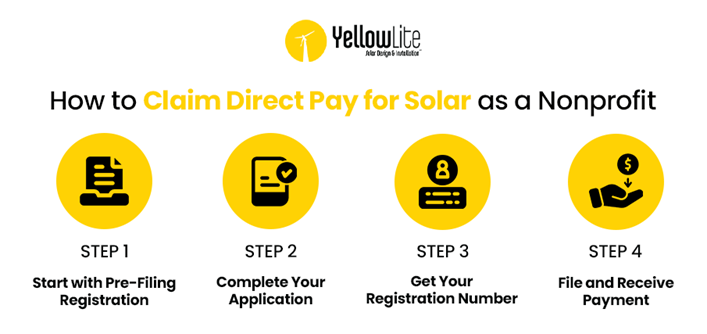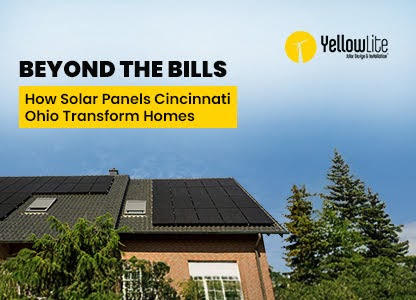For decades, nonprofits have watched businesses enjoy generous solar tax credits while they stood on the sidelines, unable to benefit because they don’t pay federal income taxes.That changes now.
Thanks to the Inflation Reduction Act (IRA), your nonprofit can finally receive the same value as a tax-paying business through a system called Direct Pay (also known as Elective Pay).
This means your organization can get a 30% cash refund directly from the IRS after installing solar panels, no tax bill required.
Let’s explore how solar panels for nonprofit organizations not only reduce energy costs but can also deliver direct financial benefits that strengthen your mission.
Key Takeaways
- Nonprofits can receive a 30% refund for solar installations through Direct Pay.
- Registration with the IRS is required before filing a tax return.
- The property must be placed in service before applying.
- Refunds are processed after filing Form 990-T with supporting documents.
- Solar investments help nonprofits reduce expenses, improve sustainability, and enhance community impact.
What Is Direct Pay (Elective Pay)?
The Direct Pay program allows tax-exempt organizations to receive the value of federal clean energy tax credits as cash refunds, even without tax liability.
Under the IRA, your organization can claim the same 30% Investment Tax Credit (ITC) that businesses receive for installing renewable energy systems.The difference? Instead of reducing taxes, you get the value as a payment directly from the IRS.
This opportunity applies to:
- Charitable and religious institutions
- Schools and universities
- Local governments and public entities
- Tribal organizations
In other words, solar panels for nonprofits now make financial sense, not just environmental sense.
Step-by-Step: How Nonprofits Claim the Direct Pay Refund

Step 1: Pre-Filing Registration
Before you can file for Direct Pay, you’ll need to register through the IRS Pre-Filing Registration Portal at irs.gov/eptregister.
You’ll need:
- An ID.me account for identity verification
- Your nonprofit’s EIN (Employer Identification Number)
- Legal name and address (as shown on previous filings)
- Authorization to act on behalf of the organization
Tip: Submit your registration at least 120 days before you plan to file your tax return. This ensures the IRS has time to review and approve your application.
Step 2: Complete the Registration Application
Once authorized, log in to your Clean Energy Dashboard and complete the registration for your solar facility.
You’ll provide:
- Facility details (location, placed-in-service date, GPS coordinates)
- Ownership proof and operation permits
- Bank information for direct deposit
- The credit type - select Section 48 Energy Credit for solar
Each qualifying solar installation requires its own registration entry.
Step 3: Submit and Monitor Status
After submitting your application, you can track progress under “Your Registrations.” Statuses include:
- Awaiting Assignment
- Under Review
- Returned – Open (needs clarification)
- Returned – Closed (case closed)
- Approved
If returned “Open,” provide the requested details promptly to avoid delays.
Once approved, the IRS will issue a unique registration number for your facility, required when filing your claim.
Step 4: File and Receive Payment
Your Direct Pay refund is finalized when you file Form 990-T (Exempt Organization Business Income Tax Return). Attach:
- Form 3468 (Investment Credit)
- Form 3800 (General Business Credit)Include your registration number and report the credit amount on Part III, line 6g.
After processing, the IRS issues the refund payment directly to your organization’s account.
Why Solar Makes Sense for Nonprofits
The Direct Pay provision transforms solar panels for nonprofit organizations from a sustainability effort into a strategic financial opportunity. By taking advantage of this 30% refund, solar panels for nonprofits can reduce your operating costs, help reinvest in your mission, and set an example for your community.
1. Lower Operating Costs
Nonprofits often struggle with rising utility expenses. Solar installations cut those bills by up to 50% or more, freeing funds for your programs, community work, or staffing.
2. Financial Stability
Unlike grants or donations, solar savings are predictable and long-term, providing budget relief year after year.
3. Environmental Stewardship
Adopting renewable energy demonstrates leadership and aligns your organization with sustainability and climate goals that attract supporters and donors.
4. Community Trust and Visibility
Modern donors care about sustainability. A solar-powered nonprofit signals responsibility, innovation, and efficiency, helping build stronger community relationships.
Going solar doesn’t just cut costs; it contributes to the worldwide shift toward cleaner, more resilient energy systems. Learn more in How Solar Energy Is Driving the Global Power Generation Revolution in 2025 by YellowLite.
How YellowLite Helps Nonprofits Benefit from Direct Pay
At YellowLite, we specialize in helping organizations navigate every step, from system design and ROI projections to paperwork and IRS registration.We ensure your solar project is eligible, compliant, and optimized for maximum refund under Direct Pay.
Our goal? To help your organization power its mission with clean, affordable energy while unlocking every available financial benefit.
FAQs
1. Can nonprofits really get money back from the IRS for installing solar panels?
Yes. Under the Inflation Reduction Act’s Direct Pay (Elective Pay) provision, eligible nonprofits can receive up to a 30% cash refund from the IRS for installing solar panels. This makes solar panels for nonprofits financially viable even without tax liability.
2. How does Direct Pay work for nonprofit organizations?
Direct Pay allows nonprofit organizations to claim the same federal solar tax credits as for-profit entities, but instead of reducing taxes, they receive the credit amount as a cash payment from the IRS. This refund is claimed through Form 990-T after completing the IRS registration process.
3. What types of nonprofits qualify for solar incentives?
Most 501(c)(3) organizations, schools, religious institutions, and local governments are eligible for Direct Pay. Any tax-exempt group with a valid Employer Identification Number (EIN) can typically qualify for solar panels for nonprofit organizations as long as the system is placed in service and properly registered.
4. What are the main benefits of installing solar panels for nonprofits?
Installing solar panels for nonprofits helps lower long-term energy costs, reduces carbon emissions, and demonstrates environmental responsibility. It also provides financial stability by cutting utility expenses and unlocking IRS incentives through Direct Pay.
5. How can YellowLite help nonprofits with solar installation and Direct Pay?
YellowLite provides end-to-end support, from solar system design and installation to guiding nonprofits through the IRS registration and refund process. Our goal is to make solar panels for nonprofit organizations simple, compliant, and cost-effective.




